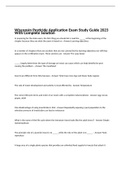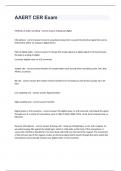4 Evidence Based Geriatric Nursing Protocols for Best Practice 6th
Edition Boltz Test Bank
Chapter 1: Developing and Evaluating Clinical Practice Guide lines: A
Systematic Approach
Multiple Choice Test Questions
1. Models of evidence -based practice (EBP) involve which of the following steps when
determining the process of developing protocols? Select all that apply.
*a. Develop an answerable question
b. Compare the evidence to what one feels to be true
*c. Critically appraise the evidence
*d. Locate the best evidence
Rationale: Evidence -based practice (EBP) involves five steps:
1. Develop an answerable question
2. Locate the best evidence
3. Critically appraise the evidence
4. Integrate evidence into practice using clinical expertise with attention to patient’s values and
perspectives; and
5. Evaluate the outcome(s)
Comparing the evidence to what one feels to be true is not a part of evidence -based practice.
2. When critically evaluating level of evidence is at the
bottom of the level of evidetnhceee(vLidOeEnc) ehiuesreadrcihnyapsyturadmy,idw?hich
*a. Opinions of respected authorities
b. Systematic reviews of Clinical Practice Guidelines (CPGs)
c. Single experimental studies (Randomized Controlled Trials)
d. Nonexperimental studies
Rationale: The level of evidence (LOE) hierarchy pyramid highlights six levels of evidence.
Opinions of respected authorities, internationally or national ly known, based on their clinical
experience or the opinions of an expert committee, including regulatory or legal opinions, form
the lowest level of evidence (i.e., Level VI, at the bottom of the LOE pyramid). The highest level
of evidence, at the top of the pyramid, is comprised of systematic reviews, meta -analyses, or
structured integrative reviews of evidence. Evidence judged to be at Level II comes from a single
randomized controlled trial. Nonexperimental studies are considered Level IV evidence.
1 / 4
5 3. Which of the following questions are based on the PICO format? Select all that apply.
*a. In patients with osteoarthritis of the knee, is hydrotherapy more effective than traditional
physiotherapy in relieving pain?
*b. For obese children, does the use of community recreation activities compared to
educational programs on lifestyle changes reduce the risk of diabetes mellitus?
*c. For deep vein thrombosis, is D-dimer testing or ultrasound more accurate for diagnosis?
d. Do adults who binge drink have higher mortality rates?
Rationale: PICO stands for:
P - Population or patient problem
I - Intervention
C - Comparison group or standard practice
O - Outcomes
PICO format is used to frame the research question and facilitate literature search. Each research
question is narrowed down to clearly state the population or the patient problem, the intervention
being studied, the comparison group , and the outcome measures. In the question “In patients
with osteoarthritis of the knee, is hydrotherapy more effective than traditional physiotherapy in
relieving pain?”, patients with osteoarthritis form the population, hydrotherapy is the
intervention that is being compared with traditional physiotherapy, and pain relief is the expected
outcome. In the question “For obese children, does the use of community recreation activities
compared to educational programs on lifestyle changes reduce the risk of diabetes mellitus?”,
obese children form the study po pTuElaStiTonB,AuNseKoSf EcoLmLmEuRn.ityCOreMcreation services is the
intervention, being compared to educational programs on lifestyle changes, and reducing the risk
of diabetes mellitus is the expected outcome. In the question “For deep vein thrombosis, is D-
dimer testing or ultrasound more accurate for diagnosis?”, deep vein thrombosis is the patient
problem, D-dimer testing is the intervention, being compared to ul trasound for accuracy of
diagnosis, that is the expected outcome. The question “Do adults who binge drink have higher
mortality rates?” does not follow the PICO format. In this question, adults form the population
being studied, binge drinking is the intervention, and higher mortality rate is the outcome being
studied. However, the comparison group is not defined and stated in the question.
2 / 4
6 4. Which of the following statements regarding the AGREE II instrument are true? Select all
that apply.
*a. The AGREE instrument has 6 quality domains with 23 items divided among these
domains.
*b. Each domain is rated on a 4-point Likert -type scale from “strongly disagree” to “strongly
agree” by a number of appraisers.
c. The six domain scores are aggregated into a single quality score.
d. The reliability of the AGREE instrument is decreased when each guideline is appraised by more
than one appraiser.
Rationale: The AGREE II instrument has six quality domains: scope and purpose, stakeholder
involvement, rigor of development, clarity and presentation, application, and editorial
independence. A total of 23 items are divided into these domains. Each domain is rated o n a 4 -
point Likert -type scale from “strongly disagree” to “strongly agree” by a number of appraisers.
Appraisers evaluate how well the guideline they are assessing meets the criteria of the six quality
domains. The six domain scores are independent and should not be aggregated into a single
quality score. The reliability of the AGREE instrument is increased, not decreased, when each
guideline is appraised by more than one appraiser.
5. Four appraisers give the following scores, as shown in the table below, for domain 1 (Scope
& Purpose) in the AGREE II instrument. What will be the scaled domain score?
Item 1 Item 2 Item 3 Item 4
Appraiser 1 5 6 TESTB N6 KSELL R17.COM
Appraiser 2 6 6 7 19
Appraiser 3 2 4 3 9
Appraiser 4 3 3 2 8
16 19 18 53
a. 53%
*b. 57%
c. 47%
d. 19%
Rationale:
Maximum possible score = 7 (strongly agree) × 3 (items) × 4 (appraisers) = 84
Minimum possible score = 1 (strongly disagree) × 3 (items) × 4 (appraisers) = 12
The scaled domain score will be:
Obtained score − Minimum possible score
Maximum possible score −Minimum possible score
53 − 12 × 100 = 41 × 100 = 0.5694 × 100 = 57%
84 − 12 72
3 / 4
7 TES 6. A 59 -year-old patient is diagnosed with acute biliary pancreatitis and noninfected pancreatic
necrosis on contrast enhanced computed tomography scan. The clinician plans to start a
course of prophylactic antibiotics. Which study design is appropriate to evaluate if antibiotics
prevent infection of noninfected pancreatic necrosis and decrease mortality?
a. Case -controlled study
b. Randomized controlled trial
*c. Systematic review and meta -analysis
d. Prospective cohort study
Rationale: Systematic review and m eta-analysis of previous randomized control trials to
evaluate use of antibiotics in preventing infection of noninfected pancreatic necrosis and
decreasing mortality will be the appropriate study design in this case. Systematic reviews and
meta -analysis constitute the highest level of evidence (Level I according to the level of evidence
hierarchy pyramid).
Case -control studies are observational studies used to identify factors that may contribute to a
medical condition by comparing subjects who have that condition/disease (the “cases”) with
subjects who do not have the condition/disease but are otherwise sim ilar (the “controls’). Case -
control studies require fewer resources but more time; also the evidence obtained is inferior to
other types of study designs (Level IV on the level of evidence hierarchy pyramid). Thus, this
will not be an appropriate study de sign in this case. A randomized control trial is a study design
with two study groups: the experimental group, where the intervention being studied is applied;
and the control group, where no intervention is used or a placebo is used instead. A randomized
control tri al can be used in this case toTeBvaAluNaKteSifEaLnLtibEiRot.icCs OprMevent infection of nonin fected
pancreatic necrosis and decrease mortality. However, it will be difficult to find matching controls
(with the same stage and severity of disease, and other matching demographic characteristics).
Also, the study will require significant time, as the two study groups will have to be followed up
for a significant period of time to see results. The evidence obtained f rom a single randomized
control trial will still be inferior (Level II on the level of evidence hierarchy pyramid) as
compared to that from meta -analysis and systematic review. A prospective cohort study follows
over time a group of similar individuals ( cohorts ) who differ with respect to certain factors under
study to determine how these factors affect rates of a certain outcome . Such studies are important
for research on the etiology of diseases. In a prospective cohort study, at the time of enrolling
subjects and collec ting baseline exposure information, none of the subjects have developed any
of the outcomes of interest. After baseline information is collected, subjects are followed
“longitudinally,” i.e., over a period of time, usually for years, to determine if and wh en they
become diseased and whether their exposure status changes outcomes. Thus, this will not be an
appropriate study design to assess impact of an intervention. Powered by TCPDF (www.tcpdf.org)
4 / 4






